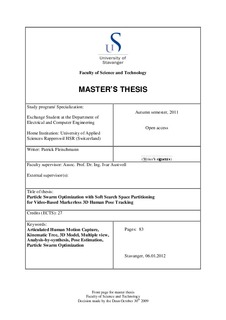| dc.contributor.author | Fleischmann, Patrick | |
| dc.date.accessioned | 2012-05-14T08:01:36Z | |
| dc.date.available | 2012-05-14T08:01:36Z | |
| dc.date.issued | 2012 | |
| dc.identifier.uri | http://hdl.handle.net/11250/181773 | |
| dc.description | Master's thesis in Information technology | no_NO |
| dc.description.abstract | The task for this master’s thesis was to develop, implement, and evaluate
an algorithm for markerless human pose tracking. The algorithm should be
based on the freely available HumanEva framework to enable a quantitative
comparison to the state of the art. This framework uses an articulated body
model to estimate the pose in an analysis by synthesis approach. Some of
the hard problems of markerless motion capture come from self-occlusions and
3D-2D mapping ambiguities. These problems are alleviated by using multiple
cameras. But the hardest problem remains: The high number of parameters
that define the pose of the body model. This thesis proposes a new algorithm called soft partitioning particle swarm
optimization (SPPSO) which formulates pose tracking as an optimization of
the 31 parameters that define the pose of the body model. The optimization
objective is a fitness function which represents the match between the body
model and the video frames. To tackle the dimensionality problem, SPPSO
divides the optimization into two stages that exploit the hierarchical structure
of the model. The first stage only optimizes the six most important parameters
that define the global orientation and position of the model. In contrast to
hard hierarchical partitioning schemes, soft partitioning refines the estimation
of these parameters in the second optimization stage. In addition to presenting
SPPSO, the thesis also provides a literature review of the current research in
the field with an emphasis on approaches that use particle swarm optimization. The performance of SPPSO was evaluated in various tracking experiments on
the Lee walk sequence, a standard dataset from the HumanEva framework
which contains multi-view video and ground truth motion capture data. The
most important result of these experiments is that SPPSO performs better
than the annealed particle filter, a common benchmark algorithm, at a frame
rate of 20fps, and equally well at 60fps. The better performance at the lower
frame rate is attributed to the explicit exploitation of the hierarchical model
structure. The experiments also showed that SPPSO performs better than
a single-stage global optimization and better than a variant with hard par-
titioning. An important conclusions from the literature review is that any
future developments should combine a stochastic global optimization, such as
SPPSO, with a local refinement stage to make tracking more accurate. The
global optimization stage allows such an algorithm to recover from tracking
failure and the local refinement efficiently improves the tracking accuracy. | no_NO |
| dc.language.iso | eng | no_NO |
| dc.publisher | University of Stavanger, Norway | no_NO |
| dc.relation.ispartofseries | Masteroppgave/UIS-TN-IDE/2011; | |
| dc.subject | signalbehandling | no_NO |
| dc.subject | informasjonsteknologi | no_NO |
| dc.subject | articulated human motion capture | no_NO |
| dc.subject | kinematic tree | no_NO |
| dc.subject | analysis-by-synthesis | no_NO |
| dc.subject | particle swarm optimization | no_NO |
| dc.title | Particle swarm optimization with soft search space partitioning for video-based markerless 3D human pose tracking | no_NO |
| dc.type | Master thesis | no_NO |
| dc.source.pagenumber | 83 | no_NO |
